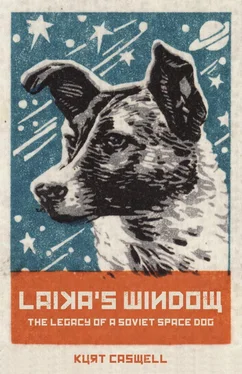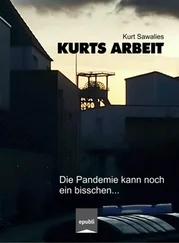Black-and-white file footage taken by a camera mounted in the Mercury spacecraft is grainy, and it stops and starts in shifting frames like an old-time silent movie, but you can see Ham during his flight, the camera catching the top of his head in motion, and occasionally a portion of his eyes and face. At times his head bobs about in a quiet rhythm, as if he’s motoring down a dirt road in a pickup truck, and then it tosses violently forward and back, his eyes closed, his mouth opened, his lips stretched back, his white teeth and sharp canines visible as he bears the acceleration of the rocket. And then he returns to that soft bobbing as the spacecraft enters microgravity and his eyes come into view in the film, calm and dark. He appears to be completely at ease, performing his tasks at the control panel.
While Ham performed his tasks, the ground crew accounted for the anomaly during engine burn. Ham would remain in microgravity for one minute longer than planned, because instead of 115 miles altitude the rocket had achieved 155 miles altitude and would splash down at least 130 miles farther down range. The anomaly also caused a sudden loss in pressure inside the spacecraft, a drop from 5.5psi to 1psi. Ham’s capsule inside the spacecraft had its own pressure and air system, but had he been inside the Mercury without this protection, the low pressure would have killed him. It would have killed an astronaut too.
For six minutes Ham floated in microgravity performing his tasks, proving that when an American astronaut made the journey he too would be able to endure the acceleration of the rocket and work in space. Then the Mercury spacecraft turned back toward the Earth. On its descent, the braking chutes did not perform optimally, as part of the system had been jettisoned early, so when the capsule hit the ocean’s surface, it hit hard, and in rugged seas. The impact breached the hull and jammed a valve open, and Ham’s ship started taking on water as it rode seven-foot swells. Of course, Ham didn’t know his ship was taking on water, that it was going down, and probably wouldn’t know even when it went down, when it went under, falling to the bottom of the sea, the air running out as he suffocated and died. He would feel a tightening in his chest, an increase in his pulse and respiration, perhaps an adrenalin dump in his body as he panicked, and then it would all slow down and he would drift into a forgotten sleep. But Ham still had time, and rescue was on the way.
It would take the closest ship, the USS Donner , nearly an hour to arrive at the scene. Navy frogmen dropped from a helicopter and attached tow cables to Ham’s capsule. The pilot then drew back on the stick and pulled the spacecraft out of the sea. Suspended from the helicopter, some eight hundred pounds of water drained from the spacecraft as the pilot set it gently down on the deck of the Donner . Ham’s flight, from liftoff to splashdown, had taken seventeen minutes.
The team removed the cover from Ham’s capsule, and there sat the world’s first space chimp, blinking. He was in good condition, though mildly dehydrated from his long wait on the launchpad, and he had bruised his nose during the hard landing. Ham was posed for photographs, one shaking the hand of the Donner ’s commander, Richard Brackett. In the photo he appears calm, even happy, still strapped into his seat, his face illuminated by the sun. In another photograph Ham is being offered an apple. He is baring his teeth, as if smiling, as he reaches out for the apple with both hands, his body still strapped against his seat, his black eyes focused. It had been hours since he had anything to eat. That photograph circulated in newspapers all over the world. Here is Ham, the happy space chimp, the captions read, enjoying a postflight snack. He has just returned to Earth after a successful flight into space for the glory of America.
Some years later the renowned primatologist Jane Goodall examined these photographs of Ham. In an interview for the documentary film One Small Step , she remarked that the look on Ham’s face “is the most extreme fear that [she had] ever seen on any chimpanzee.”
¤
With the success of Ham’s test flight, the US was now ready to send a man into space. They chose Mercury pilot Alan Shepard, but before they could get that done the Soviets put Yuri Gagarin into orbit. Shepard went up about a month later, and like Ham, he did not enter orbit. He went up to 116 miles altitude and came back down. Still playing catch-up to the Soviets, the US would next test its readiness to orbit a man around the Earth. That’s where Enos came in.
Enos was not a friendly chimp like Ham. “He wasn’t really mean” either, Dittmer said in his 2012 interview with George House. “He just didn’t take to cuddling. That’s why in any pictures you ever see of Enos, you don’t see anybody holding him.” When moving Enos from his living quarters to training stations, he had to be led by a strap connected to his wrist. He didn’t care much for the company of people and was prone to nipping and biting when agitated, and the strap helped keep a bit of distance between the handler and those sharp teeth. When officials came to the base and toured the chimp colony, Enos sometimes threw feces at them as they peered in through the cage. And he had developed the unsavory habit, when he had such an audience, of pulling down his diaper and stroking his penis. Airmen at Holloman began to call him “Enos the Penis.”
The rocket carrying Enos ascended into the sky on November 29, 1961, at 10:08 a.m. Enos endured a lift maximum of 7.8g, and then the rocket settled into its arc and pushed out into Earth orbit. The flight plan was to orbit Enos three times and bring him back down. During the flight and in orbit, Enos worked the levers on the control panel. According to Burgess and Dubbs, trainers had also incorporated rest periods in his work, and he took these rest periods as he was trained to do. At one point the capsule began to heat up, but then it returned to a tolerable temperature range. Following that, a wiring malfunction caused several undeserved electrical shocks through the bottom of Enos’s feet, but he kept to his program, pulling levers and then resting as scheduled, the spacecraft whirling around the Earth.
Before flight, the medical team had fitted Enos with an internal balloon catheter to prevent him from playing with his penis. In training, they had first tried an external catheter, but Enos quickly and easily removed it. Then they tried an internal catheter, but Enos pulled it out. So for his big flight, they inserted a balloon catheter, in which the catheter tube extends from a plastic balloon inside the bladder, inflated with water, the tube of which runs down through the urethra and out the penis end. To pull that out when the balloon was inflated would not only require a great deal of strength; it would also be very painful. Enos left it alone, but certainly he didn’t like it. And why did the team go to such trouble to prevent Enos from masturbating anyway? Was there some danger to masturbating in space? Would it interfere with his tasks onboard the spacecraft, or was it rather that the ground crew found it unsightly?
In flight, Enos worked the control panel, pulling this lever and then that lever in sequence, as he was trained to do. He did everything just right, but the wiring malfunction kept the shocks coming into the bottom of his feet. Zap. Zap. Zap. He worked the levers faster to get those shocks to stop. They always stopped, those shocks, when he worked the levers properly. And he was working the levers properly. It was the only thing he knew how to do, but the shocks kept coming. Zap. Zap. Zap. He hammered away at the panel. Zap. Zap. Zap. He hammered away. And then, his frustration rising, he came into awareness of another awful problem: what was this thing down his shorts? Enos reached into the folds of his flight suit, grasped the lead end of the bubble catheter, and pulled it out. The pain must have been unsurvivable, drawn deep from the middle of his body as the bubble, still inflated with water and the long tube attached, came sliding out. But then it was over, and Enos was likely filled with a pleasant sensation of relief and ease. As that feeling of pleasure overtook him, Enos did the only sensible thing he could do: he reached down to dandle himself. We know this because it was all caught on film. What we will never know for certain is whether Enos was merely rubbing the source of his pain after pulling the catheter out or on his way to finishing off the world’s first space jack.
Читать дальше












